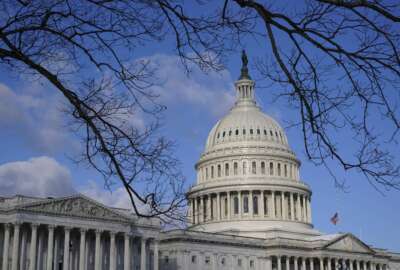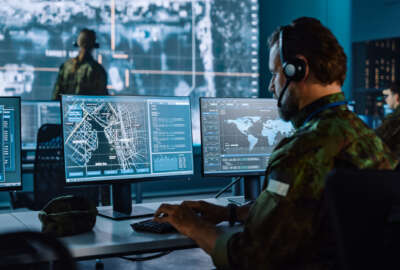Replacing this federal scientist requires a nationwide search
Ralph Semmel, director of the Applied Physics Laboratory for the last 15 years, is stepping down, and discusses his work for DoD, NASA and national security.
Given the pace of scientific discovery, 40 years is a long time. That’s how long the next guest has worked the Johns Hopkins Applied Physics Laboratory. He’s directed it for the last 15 years, and overseen research on behalf of the Defense Department, NASA and the Intelligence Community. Ralph Semmel joined the Federal Drive with Tom Temin for his exit interview upon retirement.
Interview transcript:
Tom Temin I want to start with a very basic question. You are at the Applied Physics Laboratory. That sounds like practical applications of physics and not like you’re trying to overturn the theory of relativity.
Ralph Semmel That’s true, actually. You can view applied physics as a bridge between more theoretical physics and engineering. So we’re applying basic physics to the extent that we can for engineering solutions.
Tom Temin And sounds like most of the work over the years has been done for the Defense Department, NASA, federal entities — has it been all federal? Or do you have other clients that could use this kind of research and applied research outside of the government?
Ralph Semmel The vast majority of our work is federal, the work is federally funded, we do some work for industry, but we serve as a trusted agent of the government and have to be careful about conflicts of interest with industry, since we have to serve as, if you will, as an independent broker.
Tom Temin Sure, and not much of industry requires hypersonic projectiles or directed energy that can zap something at 1000 yards, safe to say?
Ralph Semmel Yeah, as much as they may want that at times, no, it’s not that applicable. On the other hand, if you take a look at the work we’ve done in brain control interfaces, we have done work with Meta, for example, in that area.
Tom Temin In that sense, you’re kind of the latter days Xerox PARC, in some ways.
Ralph Semmel Yes, you could think of it that way. So there’s a lot of technologies that we work on that potentially do have commercial viability; you can imagine cyberdefense work, you can imagine work in the biology area as well.
Tom Temin And when I think of physics, I think of physical things. And you’ve mentioned biology and cybersecurity — maybe just an explainer briefly how physics applies to things like software.
Ralph Semmel First, you have to put the name in context. The name was given when the lab was founded back in 1942. And at the time, we were focused on something called the proximity fuse for defense against airplanes in the Pacific. And today, we’ve evolved extensively beyond physics. And so things like biology, artificial intelligence, cyber, space in general, these areas are areas that evolved from our original physics work that go but that go well beyond traditional physics.
Tom Temin And so how do you and how does the government, say, adjudicate between the [Federal Funded Research and Development Centers (FFRDCs) throughout the country, and some of the simply large academic research centers that a lot of them are pursuing similar type of work.
Ralph Semmel There are 15 what are called UARCs – university affiliated research centers – across the nation. APL is by far the largest. We have over well over 9,000 staff, it’s about a $2.5 billion a year operation. There’s a tremendous overlap, if you will, with some of the FFRDCs. We draw on academia for results that we would then use in development of prototypes, we work with the FFRDCs to assist the government, we transition technologies to industry. And so, we each have our own niches, if you will.
Tom Temin And you have been director for 15 years. And you were there, though, at the lab for 40 years, what have been some of the advances that you’re most impressed with?
Ralph Semmel It’s been a phenomenal run all the way across. If you take a look, since I’ve joined the laboratory, the work has evolved immensely. You mentioned hypersonics before, for example. That is work that I have seen evolve from the lab since the the earliest days. If you take a look at the work we’ve done in biology, so for example, we’ve done an immense amount of work in bio threat detection and mitigation. That is not work that we did 40 years ago. Cyber: relatively new area in the past couple of decades. You look at our work in artificial intelligence today, where we have a few hundred folks that are focused on core research and development in AI and thousands of people that are using it today. So it’s been just a tremendous journey.
Tom Temin We’re speaking with Dr. Ralph Semmel. He’s about to retire as the director of the Johns Hopkins Applied Physics Laboratory. Tell us a little bit about yourself; what type of scientist are you and do you get a chance to put your eye into the microscope or your hand of the keyboard, or your gloved hand to the hot beaker anymore?
Ralph Semmel Yeah, well, usually when my hand is on the keyboard, it’s sending email these days. It used to be doing pretty extensive development in, of all things, artificial intelligence, which I mentioned. It was a very different type of AI when I was doing hardcore research in that area. I do get to look through microscopes, I do get to play with things, but I’m living vicariously through the tremendous initiatives and efforts of our staff these days.
Tom Temin And just a question about artificial intelligence, people like to say that it’s been around for 40 or 50 years, and there was a famous test, to say that if someone couldn’t tell it was a computer answering them that was artificial intelligence, or Turing test. And in some ways, even now, it’s just a certain type of if-then logic, but on a scale that modern computing and the memory, and the data available has kind of powered, but is it fundamentally different now with what everyone’s talking about, versus the days when people were seeking the Turing Test?
Ralph Semmel I do believe it’s very different. And I do believe that we are at a significant inflection point in AI. The if-then logic that you were alluding to, and this started back in 1956 at the Dartmouth conference for AI, that was a much more if-then type of logic based on expert systems. The technology today is based on neural nets, which actually go all the way back in AI, many, many decades back in AI as well. But the advances in hardware and large language models that have been made possible today have fundamentally transformed the way we think about machine learning and what’s possible.
Tom Temin Is the difference then that the modern algorithms, the modern models, rewrite their own logic based on a cycling, whereas the older types of software, you could throw more and more data at it, but yet, it was the same gates, if you will, the same if-then questions?
Ralph Semmel The older systems would have certain limits to what they could infer, and when you reach those limits, the systems would just kind of do a hard crash. Today, the systems are much more stochastically or probabilistically based, if you will. And so what they are doing is, they’re anticipating what the next thing would be. So when you’re generating an answer to a question, you’re basing that based on the inputs, and what’s most likely to follow.
Tom Temin All right, and just broadening the aperture here for the different types of research. What, in your opinion, as you depart, are some of the grand challenges for federal applications, especially in the military? I mean, some of them have been around for a while, but we have this pacing threat, and what they’re now calling an absolute threat from some nations.
Ralph Semmel It’s a pretty dangerous world we live in today. And if you look at things like hypersonics, and we’ve been deeply involved in that for decades, that is a real world problem. I think you can extend well beyond that, though, to drones, for example. How does one defend against hundreds or thousands of incoming drones? And using missiles to take out a drone is just not feasible, not viable, just from a financial standpoint. And so how do you use non-kinetic approaches, using energy directed energy and so on, to address those kinds of issues? If you think about the bio threat, the world is flat, biological agents can pass very quickly in the world these days. How does one mitigate against those types of those types of threats? Cyber, we’ve seen how fragile our environment is today to you know, cyber threats and inadvertent computer errors.
Tom Temin And if you could maybe just briefly touch on some of the space activities, NASA-related activities that the lab has done?
Ralph Semmel Oh, yeah. In our history we’ve had on the order of 70 missions. Just to give you some more recent examples, a number of years ago in 2015, we with a organization working for NASA that flew New Horizons past Pluto, we have Parker Solar Probe going around the sun today, it’s at four and a half million miles going down to 3.8 million miles in the next couple of years. And of course, we had DART, the double asteroid redirection test, which took advantage of both our civil and national security capabilities to demonstrate how we would save life on earth as we know it by intercepting and impacting an asteroid.
Tom Temin Yeah, that happened in the last couple of years, correct? That something hit the asteroid; it doesn’t take much, maybe?
Ralph Semmel It happened in 2022. The goal was to deflect a smaller asteroid going around a larger asteroid by 70 seconds; we actually deflected it by over 32 minutes, demonstrating the viability of using a kinetic impactor to again, save life on earth as we know it.
Tom Temin And as you depart after 38 years, and in 14, 15 years leading a major scientific enterprise on behalf of the government, do you now do what? Lots of board work, maybe sail off?
Ralph Semmel I don’t plan to cash in on it. I am really devoted to public service. And so what I would see doing after I step down, is engaging selectively in various types of public service activities to ensure the vibrancy and resilience of our nation.
Copyright © 2025 Federal News Network. All rights reserved. This website is not intended for users located within the European Economic Area.
Tom Temin is host of the Federal Drive and has been providing insight on federal technology and management issues for more than 30 years.
Follow @tteminWFED






